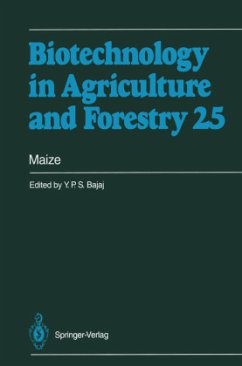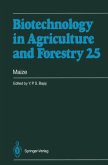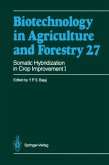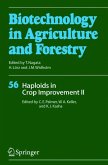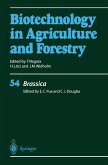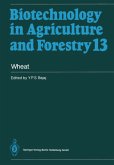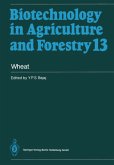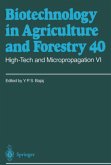- Broschiertes Buch
- Merkliste
- Auf die Merkliste
- Bewerten Bewerten
- Teilen
- Produkt teilen
- Produkterinnerung
- Produkterinnerung
Forty chapters deal with various aspects of tissue culture, in vitro manipulation, and other biotechnological approaches to the improvement of maize. They are arranged in eight sections: - In Vitro Technology, Callus Cultures and Regeneration of Plants, Somatic Embryogenesis. - Wide Hybridization, Embryo, Ovule, and Inflorescence Culture, in Vitro Fertilization. - Production of Haploids and Double Haploids, Anther and Pollen Culture. - Protoplast Culture, Genetic Transformation. - Somaclonal Variation and Mutations. - Molecular Biology and Physiological Studies. - Proteins and Nutritional Improvement. Pollen Storage, Cryopreservation of Germplasm.…mehr
Andere Kunden interessierten sich auch für
![Maize Maize]() Yashpal P. S. BajajMaize225,99 €
Yashpal P. S. BajajMaize225,99 €![Somatic Hybridization in Crop Improvement I Somatic Hybridization in Crop Improvement I]() Y. P. S. BajajSomatic Hybridization in Crop Improvement I163,99 €
Y. P. S. BajajSomatic Hybridization in Crop Improvement I163,99 €![Haploids in Crop Improvement II Haploids in Crop Improvement II]() Haploids in Crop Improvement II149,99 €
Haploids in Crop Improvement II149,99 €![Brassica Brassica]() Brassica153,99 €
Brassica153,99 €![Wheat Wheat]() Y. P. S. BajajWheat225,99 €
Y. P. S. BajajWheat225,99 €![Wheat Wheat]() Y. P. S. BajajWheat163,99 €
Y. P. S. BajajWheat163,99 €![High-Tech and Micropropagation VI High-Tech and Micropropagation VI]() High-Tech and Micropropagation VI223,99 €
High-Tech and Micropropagation VI223,99 €-
-
-
Forty chapters deal with various aspects of tissue culture, in vitro manipulation, and other biotechnological approaches to the improvement of maize.
They are arranged in eight sections: - In Vitro Technology, Callus Cultures and Regeneration of Plants, Somatic Embryogenesis. - Wide Hybridization, Embryo, Ovule, and Inflorescence Culture, in Vitro Fertilization. - Production of Haploids and Double Haploids, Anther and Pollen Culture. - Protoplast Culture, Genetic Transformation. - Somaclonal Variation and Mutations. - Molecular Biology and Physiological Studies. - Proteins and Nutritional Improvement. Pollen Storage, Cryopreservation of Germplasm.
They are arranged in eight sections: - In Vitro Technology, Callus Cultures and Regeneration of Plants, Somatic Embryogenesis. - Wide Hybridization, Embryo, Ovule, and Inflorescence Culture, in Vitro Fertilization. - Production of Haploids and Double Haploids, Anther and Pollen Culture. - Protoplast Culture, Genetic Transformation. - Somaclonal Variation and Mutations. - Molecular Biology and Physiological Studies. - Proteins and Nutritional Improvement. Pollen Storage, Cryopreservation of Germplasm.
Produktdetails
- Produktdetails
- Biotechnology in Agriculture and Forestry 25
- Verlag: Springer / Springer Berlin Heidelberg / Springer, Berlin
- Artikelnr. des Verlages: 978-3-642-63419-2
- Softcover reprint of the original 1st ed. 1994
- Seitenzahl: 664
- Erscheinungstermin: 13. Oktober 2012
- Englisch
- Abmessung: 235mm x 155mm x 36mm
- Gewicht: 990g
- ISBN-13: 9783642634192
- ISBN-10: 3642634192
- Artikelnr.: 37478421
- Herstellerkennzeichnung
- Springer-Verlag GmbH
- Tiergartenstr. 17
- 69121 Heidelberg
- ProductSafety@springernature.com
- Biotechnology in Agriculture and Forestry 25
- Verlag: Springer / Springer Berlin Heidelberg / Springer, Berlin
- Artikelnr. des Verlages: 978-3-642-63419-2
- Softcover reprint of the original 1st ed. 1994
- Seitenzahl: 664
- Erscheinungstermin: 13. Oktober 2012
- Englisch
- Abmessung: 235mm x 155mm x 36mm
- Gewicht: 990g
- ISBN-13: 9783642634192
- ISBN-10: 3642634192
- Artikelnr.: 37478421
- Herstellerkennzeichnung
- Springer-Verlag GmbH
- Tiergartenstr. 17
- 69121 Heidelberg
- ProductSafety@springernature.com
I.1 Biotechnology in Maize Improvement.- I.2 Establishment of Callus Cultures and Regeneration of Maize Plants.- I.3 Maize Propagation and Breeding Through the Culture of Reproductive Organs.- I.4 Ultrastructural Studies on Callus Development and Somati Embryogenesis in Zea mays L..- II. 1 Maize × Tripsacum Hybridization and the Potential for Apomixis Transfer for Maize Improvement.- II.2 Maize × Teosinte Hybridization.- II.3 Wheat × Maize Crosses for the Production of Wheat Haploids.- II.4Interaction of Callus of Pure Lines and Hybrids of Maize in Co-Culture.- II.5 In Vitro Culture of Maize Inflorescences.- II.6 In Vitro Fertilization in Maize.- III. 1 Anther Culture and Haploid Breeding of Maize in China.- III.2 Embryogenesis in Haploid Cell Culture of Maize.- III.3 Isolated Microspore Culture of Maize.- III.4 Advantages and Disadvantages of the Use of in Vitro/ in Situ Produced DH Maize Plants.- IV. 1 Transformation of Maize Protoplasts.- IV.2 Transformation of Maize Through Particle Bombardment.- IV.3 Transformation in Maize Using Low Voltage electric Current.- V.1 Somaclonal variation in the Progeny of CHI-31 Maize Inbred Line derived from Tissue Culture.- V.2 Insecticide-Resistant Maize Plants Regenerated in Vitro.- V.3 In Vitro Selection for Herbicide Tolerance in Maize.- V.4 In Vitro Selection for Salt Tolerance in Maize.- V.5 Approaches for the Development of Cold Tolerance in Maize Through Regenerable Callus Cultures.- V.6 Cold Tolerance in in Vitro-Grown Seedlings, Callus Tissue, and Somaclones of Maize.- V.7 Genetic variability Induced Through Mutations in Maize.- V.8 C-Banding in Zea mays.- VI. 1 Transposon Tagging Technologies in Maize.- VI.2 Molecular Aspects of Cytoplasmic Male Sterility in Maize.- VI.3 Mitochondrial Genome Organization incmsT-Regenerated Maize Plants.- VI.4 Maize Chloroplast Gene Transfer to Nucleus.- VI.5 Alcohol Dehydrogenases in Maize Cell Cultures.- VI.6 Isozymes as Markers for Embryogenic Maize Callus.- VI.7 Chilling Sensitivity of Photosynthesis in Maize.- VII. 1 Biotechnology in Nutritional Improvement of Maize.- VII.2 Corn Germ Protein: Functional Properties in a Model System and in Food Products.- VII.3 Albumins and Globulins in Maize Grains.- VII.4 Proteins and Amino Acids in Maize Kernels.- VII.5 Synthetic Peptides and Antipeptide Antibodies in Studying Zein Structure and Fingerprinting Maize Genotypes.- VII.6 Alterations in the Biosynthesis of Lysine, Threonine, and Methionine by Tissue Culture Approaches in Maize.- VIII. 1 Preservation of Maize Pollen.- VIII.2 Cryopreservation of Germplasm of Maize.
I.1 Biotechnology in Maize Improvement.- I.2 Establishment of Callus Cultures and Regeneration of Maize Plants.- I.3 Maize Propagation and Breeding Through the Culture of Reproductive Organs.- I.4 Ultrastructural Studies on Callus Development and Somati Embryogenesis in Zea mays L..- II. 1 Maize × Tripsacum Hybridization and the Potential for Apomixis Transfer for Maize Improvement.- II.2 Maize × Teosinte Hybridization.- II.3 Wheat × Maize Crosses for the Production of Wheat Haploids.- II.4Interaction of Callus of Pure Lines and Hybrids of Maize in Co-Culture.- II.5 In Vitro Culture of Maize Inflorescences.- II.6 In Vitro Fertilization in Maize.- III. 1 Anther Culture and Haploid Breeding of Maize in China.- III.2 Embryogenesis in Haploid Cell Culture of Maize.- III.3 Isolated Microspore Culture of Maize.- III.4 Advantages and Disadvantages of the Use of in Vitro/ in Situ Produced DH Maize Plants.- IV. 1 Transformation of Maize Protoplasts.- IV.2 Transformation of Maize Through Particle Bombardment.- IV.3 Transformation in Maize Using Low Voltage electric Current.- V.1 Somaclonal variation in the Progeny of CHI-31 Maize Inbred Line derived from Tissue Culture.- V.2 Insecticide-Resistant Maize Plants Regenerated in Vitro.- V.3 In Vitro Selection for Herbicide Tolerance in Maize.- V.4 In Vitro Selection for Salt Tolerance in Maize.- V.5 Approaches for the Development of Cold Tolerance in Maize Through Regenerable Callus Cultures.- V.6 Cold Tolerance in in Vitro-Grown Seedlings, Callus Tissue, and Somaclones of Maize.- V.7 Genetic variability Induced Through Mutations in Maize.- V.8 C-Banding in Zea mays.- VI. 1 Transposon Tagging Technologies in Maize.- VI.2 Molecular Aspects of Cytoplasmic Male Sterility in Maize.- VI.3 Mitochondrial Genome Organization incmsT-Regenerated Maize Plants.- VI.4 Maize Chloroplast Gene Transfer to Nucleus.- VI.5 Alcohol Dehydrogenases in Maize Cell Cultures.- VI.6 Isozymes as Markers for Embryogenic Maize Callus.- VI.7 Chilling Sensitivity of Photosynthesis in Maize.- VII. 1 Biotechnology in Nutritional Improvement of Maize.- VII.2 Corn Germ Protein: Functional Properties in a Model System and in Food Products.- VII.3 Albumins and Globulins in Maize Grains.- VII.4 Proteins and Amino Acids in Maize Kernels.- VII.5 Synthetic Peptides and Antipeptide Antibodies in Studying Zein Structure and Fingerprinting Maize Genotypes.- VII.6 Alterations in the Biosynthesis of Lysine, Threonine, and Methionine by Tissue Culture Approaches in Maize.- VIII. 1 Preservation of Maize Pollen.- VIII.2 Cryopreservation of Germplasm of Maize.

